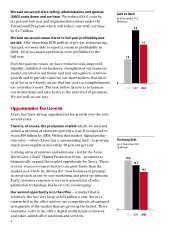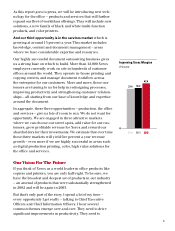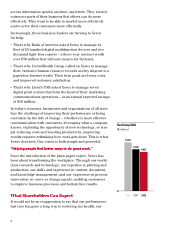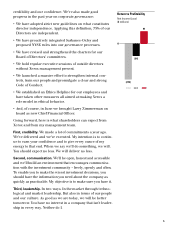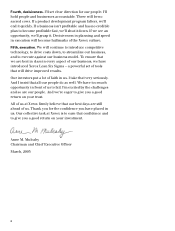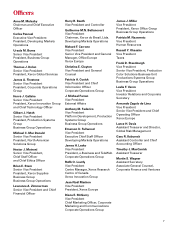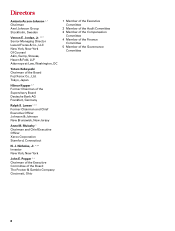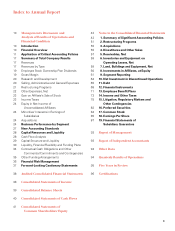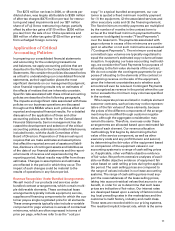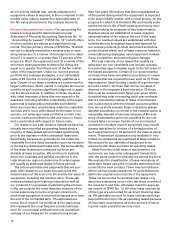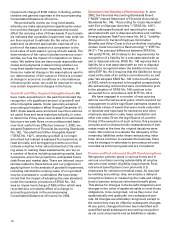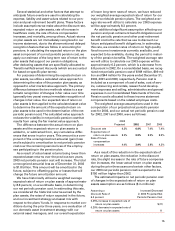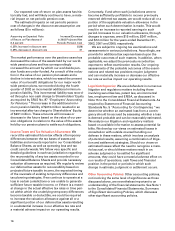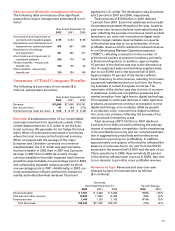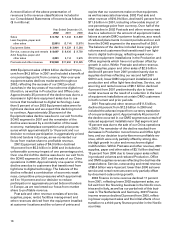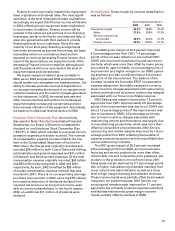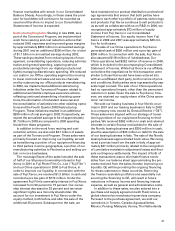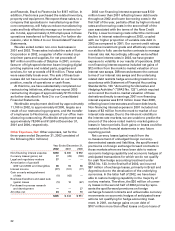Xerox 2002 Annual Report Download - page 14
Download and view the complete annual report
Please find page 14 of the 2002 Xerox annual report below. You can navigate through the pages in the report by either clicking on the pages listed below, or by using the keyword search tool below to find specific information within the annual report.
12
than five years. We believe that this is representative
of the period during which the equipment is expected
to be economically usable, with normal service, for the
purpose for which it is intended. We continually evalu-
ate the economic life of both existing and newly intro-
duced products for purposes of this determination.
Residual values are established at lease inception
using estimates of fair value at the end of the lease
term. Our residual values are established with due
consideration to forecasted supply and demand for
our various products, product retirement and future
product launch plans, end of lease customer behavior,
remanufacturing strategies, used equipment markets
if any, competition and technological changes.
The vast majority of our leases that qualify as
sales-type are non-cancelable and include cancella-
tion penalties approximately equal to the full value of
the leased equipment. Certain of our governmental
contracts may have cancellation provisions or renew-
al clauses that are required by law, such as (1) those
dependant on fiscal funding outside of a governmen-
tal unit’s control, (2) those that can be cancelled if
deemed in the taxpayer’s best interest or (3) those
that must be renewed each fiscal year, given limita-
tions that may exist on entering multi-year contracts
that are imposed by statute. In these circumstances
and in accordance with the relevant accounting litera-
ture, we carefully evaluate these contracts to assess
whether cancellation is remote or the renewal option is
reasonably assured of exercise, because of the exis-
tence of substantive economic penalties for the cus-
tomer’s failure to renew. Certain of our commercial
contracts for multiple units of equipment may include
clauses that allow for a return of a limited portion of
such equipment (up to 10 percent of the value of equip-
ment). These return clauses are only available in very
limited circumstances as negotiated at lease inception.
We account for our estimate of equipment to be
returned under these contracts as operating leases.
Aside from the initial lease of equipment to our
customers, we may enter subsequent transactions
with the same customer whereby we extend the term.
We evaluate the classification of lease extensions of
sales-type leases using the originally determined eco-
nomic life for each product. There may be instances
where we have lease extensions for periods that are
within the original economic life of the equipment.
These are accounted for as sales-type leases only
when the extensions occur in the last three months of
the lease term and they otherwise meet the appropri-
ate criteria of SFAS No. 13. All other lease extensions
of this type are accounted for as direct financing leas-
es. We generally account for lease extensions that go
beyond the economic life as operating leases because
of important uncertainties as to the amount of servic-
ing and repair costs that we may incur.
as our pricing interest rate, unless adjustment to
equipment values is required, is then compared to fair
market value rates to assess the reasonableness of
the fair value allocations to the multiple elements.
Revenue Recognition for Leases: Our accounting for
leases involves specific determinations under
Statement of Financial Accounting Standards No. 13
“Accounting for Leases” (“SFAS No. 13”) which often
involve complex provisions and significant judg-
ments. The two primary criteria of SFAS No. 13 which
we use to classify transactions as sales-type or oper-
ating leases are (1) a review of the lease term to deter-
mine if it is equal to or greater than 75 percent of the
economic life of the equipment and (2) a review of the
minimum lease payments to determine if they are
equal to or greater than 90 percent of the fair market
value of the equipment. Under our current product
portfolio and business strategies, a non-cancelable
lease of 45 months or more generally qualifies as a
sale. Certain of our lease contracts are customized for
larger customers, which results in complex terms and
conditions and requires significant judgment in apply-
ing the above criteria. In addition to these, there are
also other important criteria that are required to be
assessed, including whether collectibility of the lease
payments is reasonably predictable and whether
there are important uncertainties related to costs that
we have yet to incur with respect to the lease. In our
opinion, our sales-type lease portfolios contain only
normal credit and collection risks and have no impor-
tant uncertainties with respect to future costs.
Our leases in our Latin America operations have his-
torically been recorded as operating leases since a
majority of these leases are terminated significantly
prior to the expiration of the contractual lease term.
Specifically, because we generally do not collect the
receivable from the initial transaction upon termination
or during any subsequent lease term, the recoverability
of the lease investment is deemed not to be pre-
dictable at lease inception. We continue to evaluate
economic, business and political conditions in the
Latin American region to determine if certain leases
will qualify as sales-type leases in future periods.
The critical estimates and judgments that we con-
sider with respect to our lease accounting are the
determination of the economic life and the fair value of
equipment, including the residual value. Those esti-
mates are based upon historical experience with all
our products. For purposes of estimating the econom-
ic life, we consider the most objective measure of his-
torical experience to be the original contract term,
since most equipment is returned by lessees at or near
the end of the contracted term. The estimated eco-
nomic life of most of our products is five years since
this represents the most frequent contractual lease
term for our principal products and only a small per-
centage of our leases are for original terms longer


